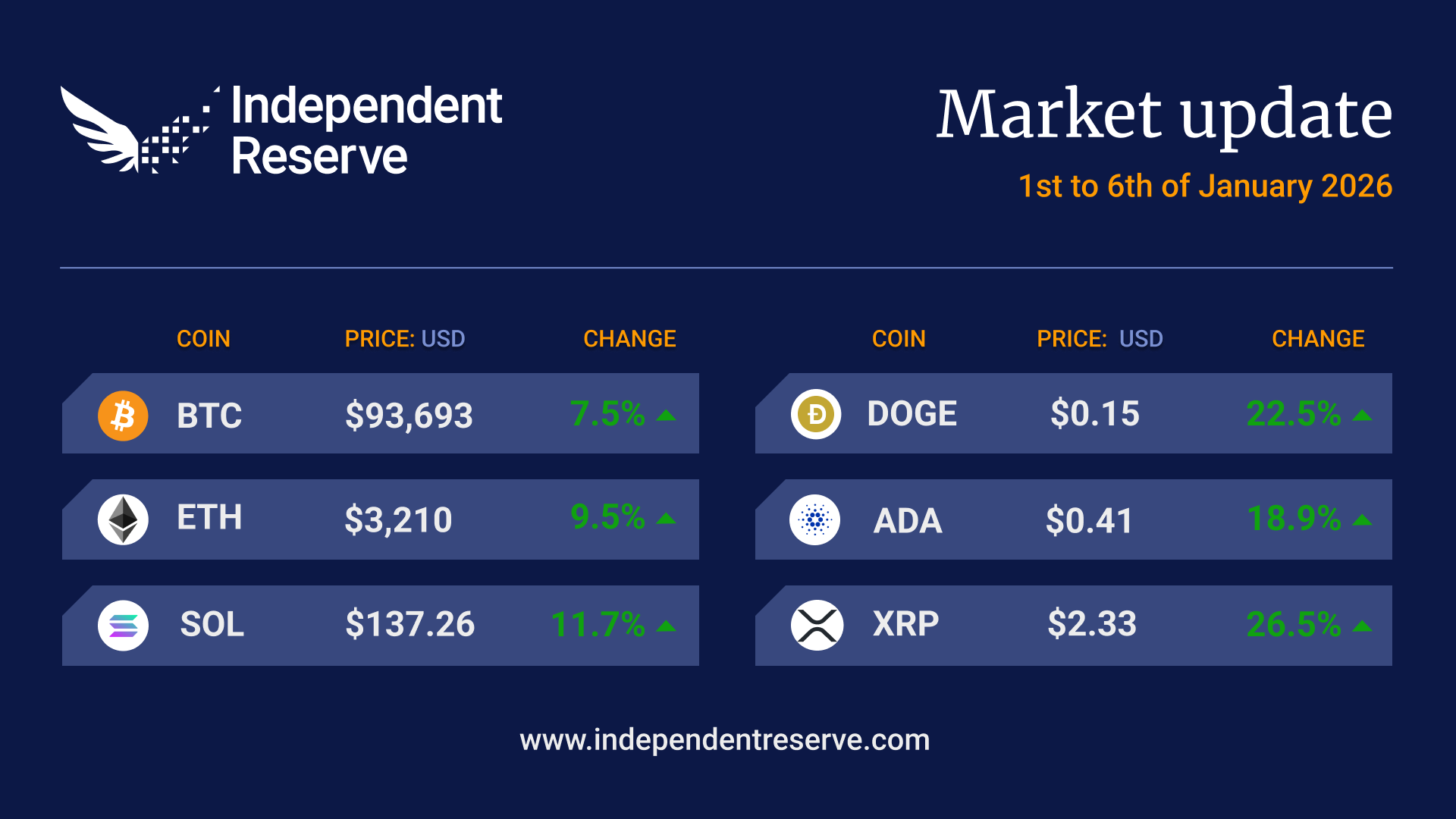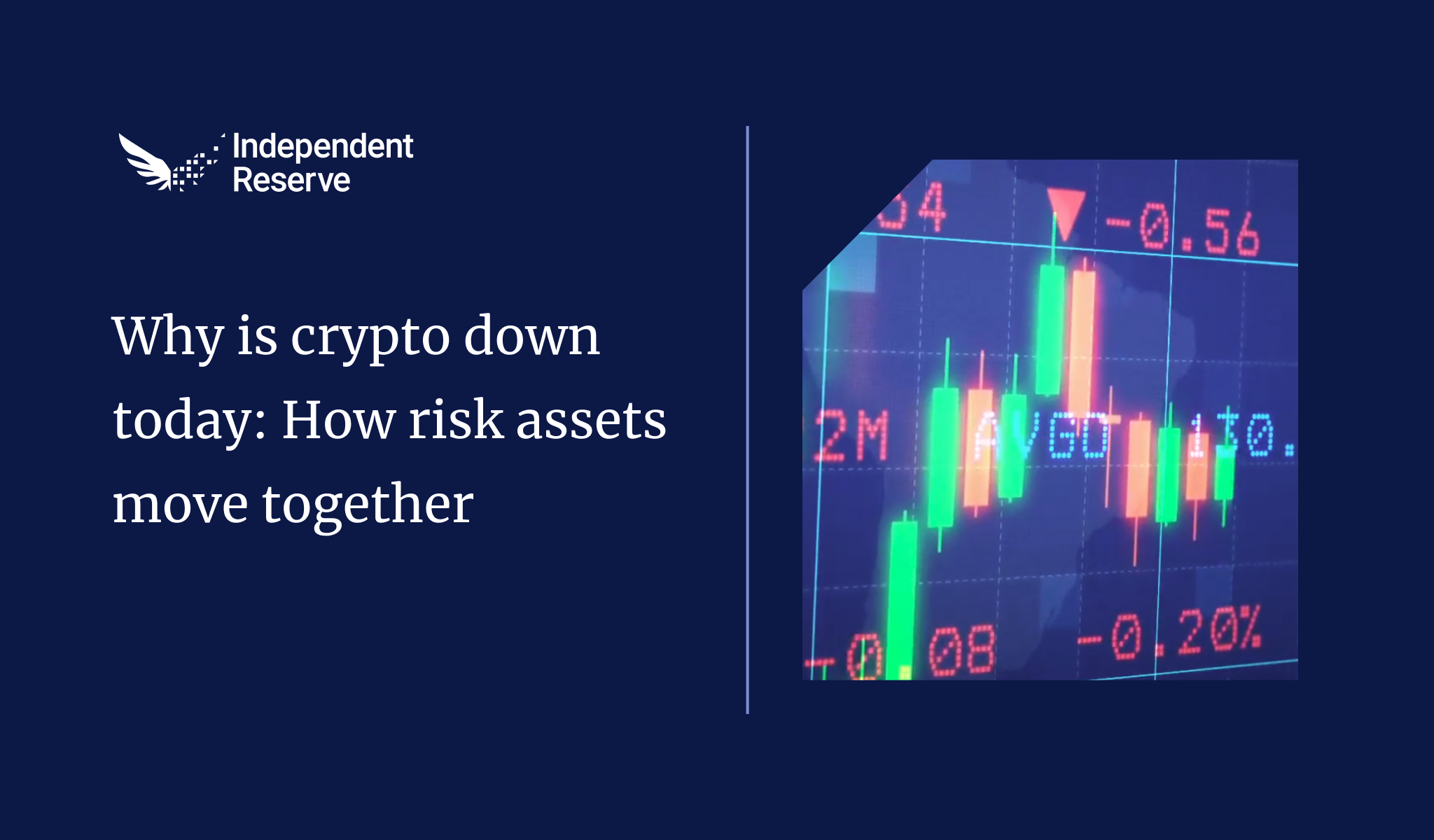In Markets
Bitcoin has been on a rollercoaster ride lately. It dropped sharply from its recent all-time high but rallied 10% mid-week on news of three potential US interest rate cuts this year. Then it fell to near the A$93K (US$61K) level following a week of outflows from the Bitcoin ETFs, recovered slowly and suddenly surged back above A$108K/US$70K overnight. Santiment reports that almost 52K Bitcoin was accumulated by wallets holding 10-10K Bitcoin on Sunday US time alone. One swallow does not a Summer make, but Rekt Capital is already musing about whether the surge marks the end of the traditional “Pre Halving Retrace “, which would make it -18% this cycle compared to -19% in 2020. At the time of writing, Bitcoin was up 5% on seven days ago to trade at A$107,729 (US$70,433), while Ethereum gained 5% to trade at A$5,541 (US$3,622). Solana pulled back 2%, Avalanche lost 6.3%, XRP and Cardano gained 2%, and Dogecoin gained 22.7%. Independent Reserve has just listed Shiba Inu, which gained 7.1% this week. The Crypto Fear and Greed Index is at 75 or Greed.

From the IR OTC Desk
Cryptocurrencies have taken a breather this week. Pricing remains highly volatile, and the meme coin frenzy appears to be slowing. A reduction in cryptocurrency-specific activity has been somewhat appropriate as outflows have remained from the Grayscale Bitcoin Trust, orders have required rebalancing, and alpha generating strategies make short-term adjustments to capture changing market dynamics.
Last week, we highlighted the March meeting for the US Federal Open Market Committee (FOMC) as being an immediate macroeconomic risk to broad asset markets and cryptocurrencies.
In summary, the FOMC left the federal funds rate unchanged at 5.25-5.50%; the FOMC has a forecast of three-quarter percentage point cuts by the end of 2024; the FOMC sees the long-term rate up from 2.5% to 2.6%.
This was significantly more positive for asset markets than previously forecast, as the FOMC appeared to ‘look through’ persistent above-target inflation to maintain the expectation of a ‘soft landing’. For now, markets remain upbeat and expect interest rate cuts this year. We continue to follow both employment and inflation data in the US incredibly closely. This week, we received US PCE inflation data for February. PCE inflation is the FOMC’s preferred measure for inflation. Due out Friday at 11:30pm AEDT, Core PCE YoY (Feb) is forecast to remain at 2.8%. Watch this space.
In Australia, the Reserve Bank of Australia (RBA) convened for their March meeting. While maintaining the current policy setting for the cash rate at 4.35%, the RBA highlighted an unclear path forward.
“The path of interest rates that will best ensure that inflation returns to target in a reasonable timeframe remains uncertain and the Board is not ruling anything in or out.”
On the economic front, the Australian employment series positively surprised last week, with the unemployment rate falling from 4.1% in January to 3.7% in February. This significant change to unemployment was driven by 116.5k new jobs, versus a market forecast of 40k new jobs. Domestic labour market tightening, as well as a whole series of collective wage negotiations that remain in the pipeline, will certainly make the task of the RBA challenging this calendar year. Watch this space.
On the OTC desk, we continue to wait for the Bitcoin halving. While activity this week has been slightly quieter, new enquiries have continued to surge – particularly out of our Singapore office. This change in activity is not unexpected, as market euphoria had certainly dominated the previous month. If anything, it should be seen as quite organic and an honest reflection of a maturing market.
Long tail assets continue to pique interest, albeit selectively. We continue to monitor the supply side dynamics of BTC as being the best indication of market sentiment and direction.
For any further information, please feel free to reach out.
In Headlines
Independent Reserve lists Shiba Inu (AU/NZ)
We are excited to announce the addition of Shiba Inu (SHIB) to our Australian and New Zealand platform (currently not available in Singapore). Shiba Inu has evolved from being strictly a memecoin into a vibrant community supported by passionate builders. Its growing ecosystem includes the ShibaSwap decentralised exchange, an NFT art incubator, and various community-driven projects. By listing SHIB, we are offering our users access to one of the most popular memecoins in the cryptocurrency space and look forward to listing more in the future.
SEC and crypto industry court battles roundup
The SEC’s case against Terraform Labs kicked off in New York today with prosecutors alleging Terra was a “house of cards”, and that co-founder Do Kwon “orchestrate(d) a multi-billion dollar crypto asset securities fraud. ” The defence’s argument is that failure doesn’t equal fraud. In the long-running Ripple case, Chief Legal Officer Stuart Alderoty said the SEC had asked the court for fines and penalties topping US$2B (A$3.05B) over an earlier ruling that sales of XRP to institutional investors were unregistered securities. There’s also speculation the judge in the Custodia Bank versus the Federal Reserve could rule in favour of the crypto bank sometime this week. Meanwhile, Texas clothing company Beba has teamed up with the DeFi Education Fund to get on the front foot and take the SEC to court. They want the court to declare its token airdrop is not a security and to help clarify the limits of the SEC’s powers.
Bitcoin ETF outflows
Perhaps due to collapsed crypto lender Genesis cashing out most of its US$1.3B (A$1.98B) in GBTC, the Bitcoin ETFs saw a solid week of net outflows. BlackRock’s ETF is on track to overtake Grayscale’s AUM within three weeks at this rate. So why isn’t Grayscale lowering its high fees to stem the outflows? Analyst James Bianco believes Grayscale might be banking on long-term holders not wanting to withdraw to avoid hefty tax bills, and/or because it’s betting that an increase in the Bitcoin price will offset its lower holdings of actual Bitcoin in terms of fee revenue. Despite a week of overall outflows, both BlackRock and Fidelity’s ETFs have notched up 50 straight days of inflows each. IBIT made up more than half of BlackRock’s net inflows for the year across its 420 ETFs, while FBTC accounted for 70% of Fidelity’s year-to-date flows.
Ether ETF approvals dim following SEC investigation
The prospects of an Ethereum ETF approval in May grew ever dimmer amid reports the SEC is investigating Ether in an attempt to see if it can classify the cryptocurrency as a security. Fortune reported the SEC had subpoenaed several companies that worked with the Ethereum Foundation, and the Foundation’s ‘warrant canary’ was removed from its website, indicating an investigation of some sort. General partner of Van Buren Capital Scott Johnsson, believes the investigation is a way to either deny or delay the approval of the ETF.
Still some hope of Ethereum ETF
Not everyone has lost hope in the prospects of an Ether ETF approval in May however, with Grayscale’s chief legal officer Craig Salm arguing that a lack of engagement from the SEC didn’t mean the process is dead. He points out that all of the issues were sorted out during the Bitcoin ETF approval process. “All of these issues were figured out and are identical,” he says. “I don’t think perceived lack of engagement from regulators should be indicative of one outcome or another.” However, some Ether ETF applicants have amended their filings to include staking, which complicates matters.
New EU rules on money laundering
Crypto X and some media outlets got very excited at the EU’s new Anti-Money Laundering Regulations supposedly banning self-custodial crypto transactions and wallets. However, Circle’s EU Strategy and Policy Director Patrick Hansen said those reports are incorrect, and P2P transfers and hardware wallets are specifically excluded from the legislation. The rules basically prohibit exchanges and merchants dealing with anonymous wallets over a certain threshold, and from dealing with privacy coins.
Institutional embrace
BlackRock has launched a US$100 million (A$153M) tokenised asset fund on the Ethereum blockchain. The fund is called the BlackRock USD Institutional Digital Liquidity and its token is called BUIDL. It aims to have a stable token value of US$1 with the opportunity for daily dividends. Meanwhile, the London Stock Exchange said it will start a marketplace for Bitcoin and Ether exchange-traded notes on May 28, subject to approval by the regulator.


